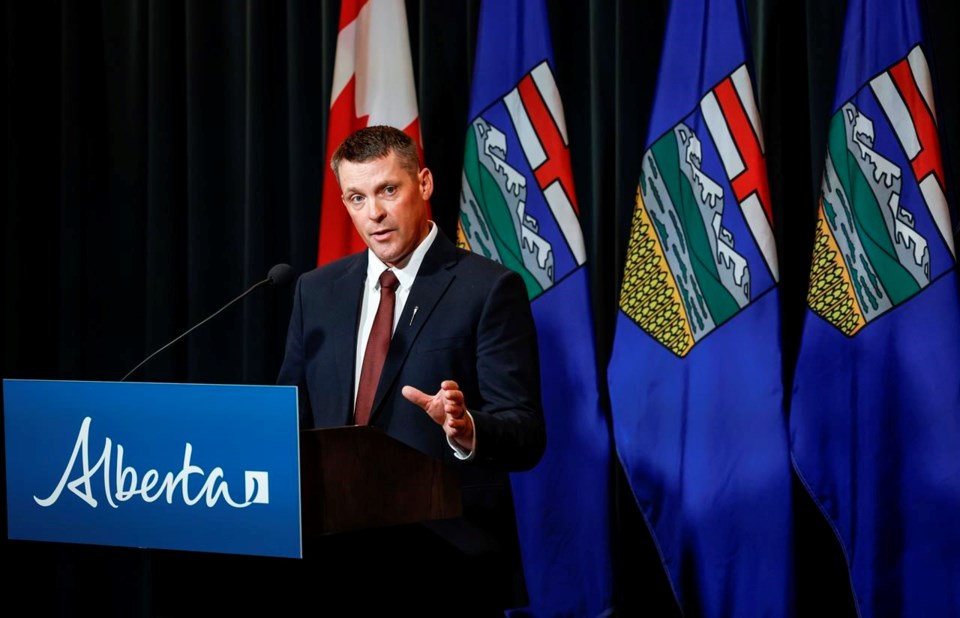EDMONTON — The Alberta government has introduced legislation promising residents will get a say in a referendum on leaving the Canada Pension Plan, but the bill does not force the government to accept the result.
The proposed Alberta Pension Protection Act mandates that a referendum be held before the province quits the CPP.
However, the question of whether the referendum result will be binding on the government will be decided once it decides to move ahead with the plebiscite.
Finance Minister Nate Horner said it would be premature to enshrine in law a binding referendum commitment.
Horner said the goal is to provide a process for a referendum while not tying the hands of future governments.
“My intent today is to provide assurance to Albertans that a referendum will be required,” Horner told reporters Thursday at the legislature before introducing the bill in the house.
“(Regarding) any specific decisions about a referendum, (it) would be far too early to presuppose any of that.
“Whether it was our government or a future government, that (decision) would have to be made at that time.”
Horner acknowledged there are concerns with the government’s pension-exit proposal, but said Albertans’ best interests remain at the forefront.
“There is active voices out there — I don’t want to get into the politics of this — making claims that we’re attempting to steal people’s pensions, things as inflammatory as that,” said Horner.
“We’re not moving ahead without the support of Albertans.”
The bill says once a government orders a referendum, it will then decide the particulars, including the wording of the referendum question, whether it’s a binding vote, whether mail-in ballots will be allowed and whether the referendum is a stand-alone event or piggybacks on another vote, such as municipal byelections.
The bill also states that any Alberta pension plan must provide benefits and contribution rates that are at least as good as those in the CPP.
It also mandates that any money transferred over from the CPP can only be used to operate a provincial pension plan.
It's not clear what must be done with any future investment returns.
Horner said Thursday that Albertans will eventually decide the investment goals of any provincial plan, including whether it should focus solely on maximizing returns or whether it should follow the Quebec pension plan model of focusing on returns but also investing in the provincial economy.
The Quebec model has prompted concerns an Alberta fund may be put at risk by investing in private ventures or in its oil and gas industry.
On Oct. 12, Horner told the Ryan Jespersen online show that the Quebec model would not be followed and there would be legislation to confirm that. On Thursday, Horner said the Quebec model was still on the table and up to Albertans to decide.
Horner’s office, in an email exchange, declined to explain why he reversed course.
Horner also acknowledged there is no quantitative benchmark for the government to use to determine if there is public appetite to move to a referendum. He said the government will rely on multiple sources, including polls and feedback from a public engagement panel headed up by former treasurer Jim Dinning.
The referendum, should it come to pass, was tentatively scheduled for 2025.
That date was thrown into doubt last week when Premier Danielle Smith, acknowledging that Albertans want a firm figure on how much the province will get from the CPP, said there will be no referendum until a hard number is nailed down.
Alberta says it is owed $334 billion, more than half of all CPP assets, while the CPP Investment Board and economists put the number more in line with Alberta’s representative CPP population of 15 per cent.
Smith said if Alberta and the federal government can’t agree on a number, the matter may have to be resolved through the courts — an option that could take years.
The issue has raised concerns across Canada on what an Alberta pullout could mean. Federal Finance Minister Chrystia Freeland has convened for Friday a virtual meeting of provincial and territorial finance ministers to discuss the Alberta exit proposal.
In Alberta, critics, including the Opposition NDP and the Canada Pension Plan Investment Board, have accused Smith’s United Conservative government of using questionable numbers and misinformation to persuade Albertans to leave the CPP and vote for a provincial plan.
They note the government's multimillion-dollar advertising and engagement campaign mentions the benefits of an Alberta stand-alone plan but omits the drawbacks.
There is also renewed confusion over Smith’s numbers surrounding participation in the 2019 Fair Deal panel, which she says helped spark the current pension debate.
Smith told her provincewide call-in radio show on Oct. 14 that about 300,000 people attended public information sessions in late 2019 and early 2020 for the Fair Deal panel, which later urged the government to pursue a referendum on quitting the CPP.
Two days later, Smith’s office said she misspoke and meant to say 3,000.
However, Smith has since returned to using the original number while increasing it to 350,000 in a speech to the Edmonton Chamber of Commerce last week and again in the house this week.
“The Fair Deal panel discussions that took place over four years ago had 350,000 people who participated,” Smith told the house during question period Wednesday.
Smith’s office did not reply to a request for comment explaining the 350,000 figure.
This report by The Canadian Press was first published Nov. 2, 2023.
Dean Bennett, The Canadian Press



